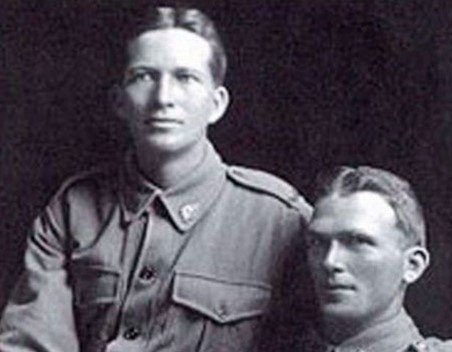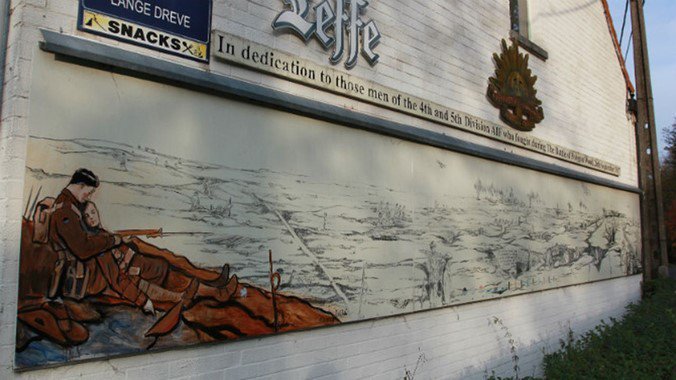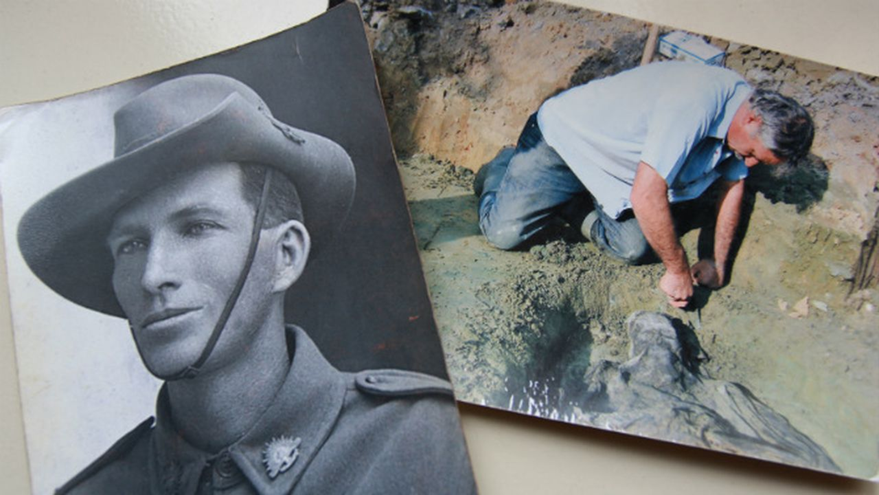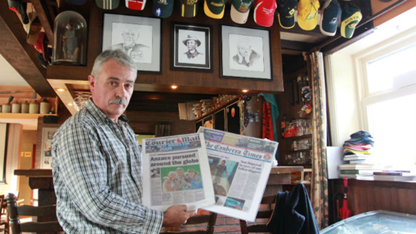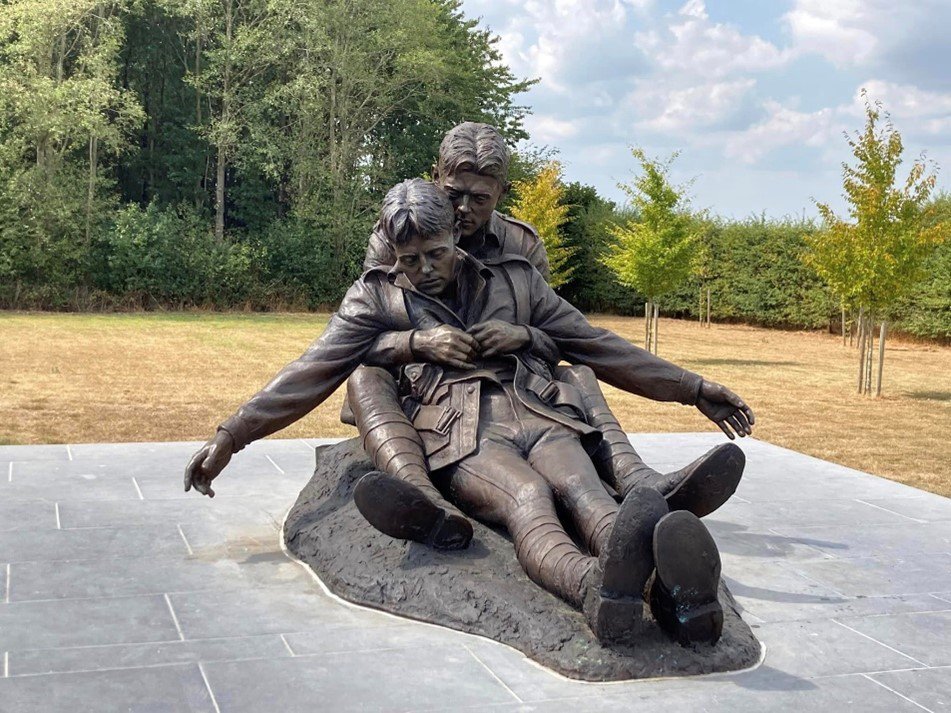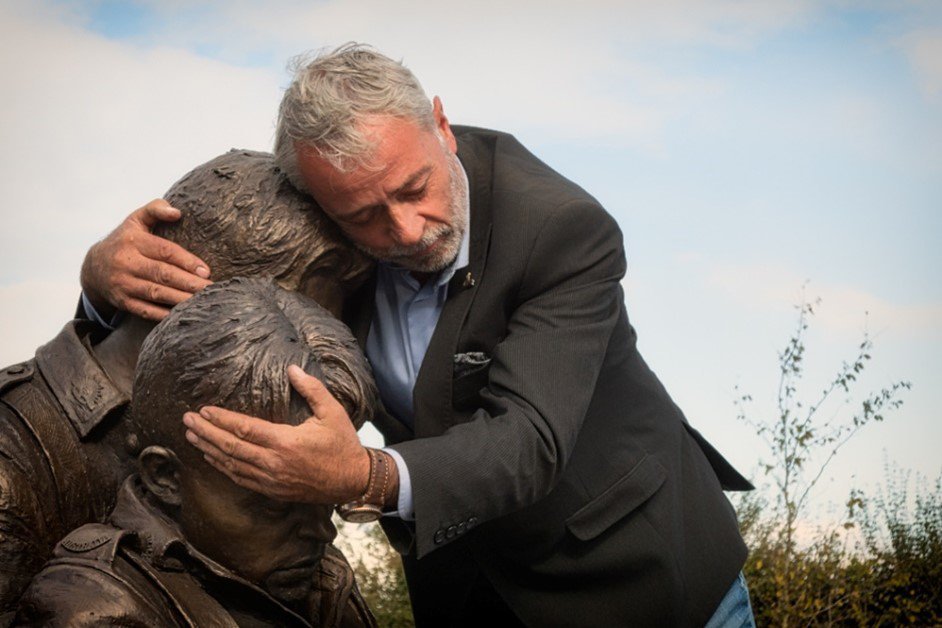As we pause on 11 November to reflect on what has been lost and what we have gained through the service of our soldiers, sailors, airmen, nurses, and all others involved in participation in the armed forces for Australia, we wish to show how our resolve to honour our lost has not diminished in the course of time, but has instead grown stronger. For example, what was understood to be possible in 1993 changed significantly with the ability to identify soldiers by the use of DNA in 2006. We hope in reviewing the following material, that you will more readily understand how Remembrance drives the work of our Association.
--- 1993 --- THE DEDICATION OF THE UNKNOWN SOLDIER, CANBERRA
Australian Prime Minister, The Hon. Paul Keating presided over the dedication of the Unknown Soldier at the Australian War Memorial in Canberra, on 11 November, 1993. In so doing, his speech has become one of the most evocative statements of reflection in the remembrance of our soldiers in all wars. It reads (in full) as follows:
We do not know this Australian's name and we never will. We do not know his rank or his battalion. We do not know where he was born, nor precisely how and when he died. We do not know where in Australia he had made his home or when he left it for the battlefields of Europe. We do not know his age or his circumstances – whether he was from the city or the bush; what occupation he left to become a soldier; what religion, if he had a religion; if he was married or single. We do not know who loved him or whom he loved. If he had children we do not know who they are. His family is lost to us as he was lost to them. We will never know who this Australian was. Yet he has always been among those whom we've honoured. We know that he was one of the 45,000 Australians who died on the Western Front. One of the 416,000 Australians who volunteered for service in the First World War. One of the 324,000 Australians who served overseas in that war and one of the 60,000 Australians who died on foreign soil. One of the 100,000 Australians who have died in wars this century. He is all of them. And he is one of us. This Australia and the Australia he knew are like foreign countries. The tide of events since he died has been so dramatic, so vast and all-consuming, a world has been created beyond the reach of his imagination. He may have been one of those who believed that the Great War would be an adventure too grand to miss. He may have felt that he would never live down the shame of not going. But the chances are he went for no other reason than that he believed it was his duty - the duty he owed his country and his King. Because the Great War was a mad, brutal, awful struggle, distinguished more often than not by military and political incompetence; because the waste of human life was so terrible that some said victory was scarcely discernible from defeat; and because the war which was supposed to end all wars in fact sowed the seeds of a second, even more terrible, war - we might think this Unknown Soldier died in vain. But, in honouring our war dead, as we always have, we declare that this is not true. For out of the war came a lesson which transcended the horror and tragedy and the inexcusable folly. It was a lesson about ordinary people – and the lesson was that they were not ordinary. On all sides they were the heroes of that war; not the generals and the politicians but the soldiers and sailors and nurses – those who taught us to endure hardship, to show courage, to be bold as well as resilient, to believe in ourselves, to stick together. The Unknown Australian Soldier we inter today was one of those who by his deeds proved that real nobility and grandeur belongs not to empires and nations but to the people on whom they, in the last resort, always depend. That is surely at the heart of the ANZAC, the Australian legend which emerged from the war. It is a legend not of sweeping military victories so much as triumphs against the odds, of courage and ingenuity in adversity. It is a legend of free and independent spirits whose discipline derived less from military formalities and customs than from the bonds of mateship and the demands of necessity. It is a democratic tradition, the tradition in which Australians have gone to war ever since. This Unknown Australian is not interred here to glorify war over peace; or to assert a soldier's character above a civilian's; or one race or one nation or one religion above another; or men above women; or the war in which he fought and died above any other war; or of one generation above any that has or will come later. The Unknown Soldier honours the memory of all those men and women who laid down their lives for Australia. His tomb is a reminder of what we have lost in war and what we have gained. We have lost more than 100,000 lives, and with them all their love of this country and all their hope and energy. But we have gained a legend: a story of bravery and sacrifice and, with it, a deeper faith in ourselves and our democracy, and a deeper understanding of what it mean to be Australian. It is not too much to hope, therefore, that this Unknown Australian Soldier might continue to serve his country - he might enshrine a nation's love of peace and remind us that in the sacrifice of the men and women whose names are recorded here there is faith enough for all of us.
--- 1917 --- JAMES & JOHN HUNTER - BROTHERS IN ARMS
The year was 1917 and the Australian 49th Battalion was fighting for the Australian Imperial Forces on the Western Front. The battle was
raging just outside Ypres in Belgium at Polygon Wood and two brothers fought side by side against the might of the German army.
Their names were Jim and John Hunter from Nanango in Queensland. The brothers had been in battle before so they knew the risks they were taking as they attacked the German lines and for the first time on the Western Front the tide was turning as the strength of the Aussie attack finally had the Germans wondering how for the first time in the war as they were losing because of the Australian efforts.
The battle was furious and the ground was covered with broken and mutilated bodies, dead animals, mud and disused army equipment amongst the smell of dead and the screaming of wounded soldiers from both sides. The Aussies were eventually triumphant under the leadership of the great Australian General John Monash but at a huge cost and in these battles alone there were thousands of Aussies being blown apart by the German artillery to the extent where there would never be even a simple headstone to remember them by.
In the midst of the Polygon Wood nightmare of a battle, John Hunter was killed and his heart broken brother Jim had little time to think what to do with his body but wanted him buried so he could find him later. He wrapped him tightly in an army issue groundsheet and buried him on his back as if resting peacefully in the field of battle.
He returned later after the battle had moved on but could not find the body and John remained in his grave as the war continued over him towards the inevitable Allied victory. There was to be no gravestone for John Hunter. The brothers were graziers in Queensland. Jim Hunter had to return to life in Queensland without ever knowing what happened to John’s body. He lived a full life and in June 2014, one of his grandchildren eventually visited the battlefield where the brothers had fought.
Many old soldiers never talked about the war. But Jim Hunter spoke always about fighting in Flanders with his older brother John (known as Jack). For Jim Hunter’s son, (also named Jim Hunter) the stories kept his Uncle Jack alive. A German shell killed Jack when he went over the trenches on September 26, 1917. Jim laid Jack down in a blanket tied with signal wire. "He wrapped him pretty well,"
says the younger Jim Hunter, 73. "They were great mates. You could see my dad loved him from the way he talked.
Near the end of his life, when he had Alzheimer's, he used to cry "Jack, Jack …""
Private John Hunter was hastily buried for later reinternment, but his body was missed when temporary cemeteries were dug up after the war. He lay unfound in Belgium for almost 90 years.
--- 2006 --- FIVE AUSTRALIAN SOLDIERS DISCOVERED NEAR ZONNEBEKE
The remains of five Australian soldiers were discovered by chance in September 2006 during roadwork and pipe-laying excavations near the small village of Westhoek. Belgian gas workers found their well-preserved remains while laying a pipe. The location is situated in the middle of the dreaded Ypres-Passchendaele Salient where up to half a million casualties on both sides fell, of which tens of
thousands were either never recovered or were unidentifiable.
One of the soldiers had been carefully buried and through forensic investigation and DNA testing this soldier was identified. He was Private John Hunter. One other was identified shortly after, another to follow in 2008. Now, at this point, we need to introduce Johan Vandewalle, a local Flemish resident, who lives near the burial site, and who is the proprietor of the ANZAC Rest Hotel. It is a pub and meeting place on a street corner on the edge of the Polygon Wood, north-east of Ieper (Ypres) in Zonnebeke. The place is filled with memorabilia from his trip to Australia (see later), and from the dead Australian soldiers whose bodies he excavated back in 2006.
Vandewalle is also responsible for the exhuming of any remains of soldiers who are found fairly consistently in the area. He is an expert in the local battles as he has lived in the area all his life and is devoted to the history of it. His life changed drastically in 2006, when he assisted in excavating the remains of what turned out to be five Australian soldiers.
Vandewalle got a call, to come to the scene at Zonnebeke - just a couple of streets from the pub - and insisted with the local police that he would excavate the bodies carefully in order to protect them from possible battlefield scavengers. Vandewalle did so with due respect, unearthing the remains of 5 soldiers – hence the "Zonnebeke 5". Somehow, Vandewalle had felt it coming. He knew that workers would be digging in the area in connection with a new gas pipe. He told them to alert him the minute that they might bump into the remains of fallen soldiers - something that happens regularly in the area. On arriving he started to dig out the soldiers’ remains.
As he slowly dug away the surrounding dirt covering the site he was confronted with John Hunter’s very well preserved body, the outline of which was clearly visible, and which was still intact, covered with a kind of plastic sheet. When he took away the sheet, the eyes of the fallen soldier looked straight at him. He was taken by the tallness of the soldier and his square jaw which made him so life-like. He became very moved by this soldier and his background and started to unravel his history.
In due course Vandewalle was informed that the body he had recovered was that of John "Jack" Hunter, who perished while on a mission for Australia's 49th Battalion in September 1917. Vandewalle thought it was his mission to do what he could to compensate this injustice just a little bit: "It was then I knew I had a mission to complete" Vandewalle explained.The A ustralian Government and Australian Army History Unit worked with Belgian authorities to identify the remains. The Australian Army through its History Unit headed the investigation into the identity of the five men, with the assistance of the Memorial Museum Passchendaele, the Department of Veterans' Affairs, and the Office of Australian War Graves. The Australian War Memorial also provided some assistance early in the piece, particularly with archival maps and documents.
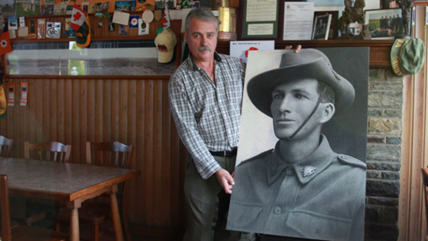
Until recently, it had been impossible to identify such remains and they were reburied as soldiers. But by taking mitochondrial DNA from a femur and matching it with the DNA of a living relative, Belgian researchers working with the Australian Army have now managed to identify three of the five soldiers. It is a difficult task. The DNA in these cases could be traced only through the female line, and living female relatives, who often have different names to their forebears, can be hard to find. The army, which takes pains to be sure it has an exact match, has so far been unable to identify the remaining two of the five soldiers found.
For example, sisters Adrienne Verco, of Brisbane, and Rosemary Sheehan, of Wales, learnt that the tests could not confirm one of the bodies was their great-uncle, Colin Neil McArthur. A saliva swab from Mollie Milliss, however, matched the DNA of her uncle, Private
Hunter. And Faye Harris, of Frankston, Victoria, was able to provide a match to the remains of her great-uncle, Sergeant Calder. Mrs Harris knew her great-uncle had not returned from World War I. But she contacted the army only after reading an article in The Age about the discovery of the bodies.
The revelation that one of the bodies was that of her great-uncle was "overwhelming" said Mrs Harris' daughter, Sue Moore, who travelled to Belgium with her sister, Anne Morrison. The sisters were sorry to know only a little about their great-great uncle, but Mrs Moore said it was "an extreme honour to be able to come and recognise his sacrifice"
--- 2007 --- FIVE DIGGERS LAID TO REST
On a day perhaps as misty as those of the battles of Passchendaele exactly 90 years before, [in 1917], the remains of five World War I Australian soldiers were laid to rest and their headstones were reinterred, on 4 October, 2007, with full military honours in the Buttes New British Cemetery at Polygon Wood, Belgium. The ceremony, before a crowd of 500 people, was attended by the Australian Governor-General, Major General Michael Jeffery, and the New Zealand Prime Minister, Helen Clark. The Governor-General's wife, Marlena, laid a sprig of golden wattle on their coffins.
Two of the soldiers - 1868 Sergeant George Calder, 51st Battalion, and 3504 Private John Hunter, 49th Battalion had been identified in
2007 through DNA analysis. Relatives of Private John Hunter, from Nanango in southern Queensland, and Sergeant George Calder, of Goldsborough in northern Victoria, laid flowers and a toy kangaroo on the coffins of their forebears before they were lowered into the earth in Buttes New British Cemetery.
An emotional Jim Hunter, nephew of Private Hunter, said he knew a great deal about his uncle because his father, also Jim, had fought beside him in Flanders and had buried him the first time.
--- 2008--- The Headlines in Australia
A third soldier, 2488 Private George Richard Storey, 51st Battalion, was identified from further DNA testing in 2008. Vandewalle even became a local hero in Australia due to his detailed work and determination. The case made the headlines in the Australian press. Vandewalle was promptly invited by the three families of the 3 Australian victims that could be identified. He was received in their villages as a real hero. "I was the right person, at the right place, at the right time" he used to say about the discovery.
The story of the Hunter brothers is a big one in Australia. TV crews have travelled to Belgium to bring the story.
--- 2015 ---
By 2015 Vandewalle had formed the view that as so many pairs of brothers fought and died in the First World War, that it is our duty to raise a memorial to all brothers who fought in the Great War. The monument would of course also serve to honour all fallen ANZAC and war soldiers in general.
Triggered by the story of John and Jim Hunter, Vandewalle started the Two Brothers Project. Original ambitions were to have the memorial erected by September 2017, to mark the 100th anniversary of the tragedy.
Vandewalle said in announcing the project: "This will be one of the most special commemorations you have ever seen, After all, this is a very special story, wouldn't you say"
--- 2020 ---
The bronze statue of the Hunter brothers would be the main feature of the Brothers In Arms Memorial Park (designed by Andy Malengier Landscape Architecture). The main feature (designed by Soren Hawkes) was made in Melbourne by Louis Laumen, Sculptor. The sculpture model had progressed to a clay sculpture ready for moulding prior to the final bronze casting phase. The scale of the finished product would be slightly larger than life size. It has been said that the sculpture's resemblance of the brothers is breathtaking.
--- 2022 ---
On 25 September, 2022, the Two Brothers Memorial featuring Jim Hunter holding his brother John in his arms, was dedicated in an emotional ceremony attended by many interested participants for the project.
NOW, RETURNING TO FROMELLES:
On 19th July, 1916, two brothers Corporal Donald David Donaldson, and Private Frank Harold Donaldson both of the 60th Battalion went into battle at Fromelles. In a letter from Don to his parents, he wrote:
“We got within 100 yards of the German trench when poor little Frank went down, badly hit in the groin. I ran to help him into a shell hole close by, when I got one through a finger of the left hand – thought my hand was gone. Then, just as I got the poor kid to the hole, he got another through the same place, and one through the arm, and I got it in the foot – blew half my foot right open. I tried to bandage Frank, but our field dressings were not long enough, and I could not make a proper job of it. Poor little Frank knew he was going, and asked me to say the Lord's Prayer with him, and said, "Poor old Dad" But he was as brave as could be, and when his time had come a few hours later he died game and said good bye to me quite calmly. In fact, he took it a good deal better than I did. I would gladly have changed places with him, for he made me feel a bit of a coward, the calm way he was taking it. So you have something to be proud of Dad, for he died the way you would have any of us die, and he has shown us the way.”
Donald returned to his lines after having to hide in a shell hole overnight. Frank ’s remains have yet to be identified. Both their stories are set out on the Fromelles Association website at www.fromelles.info under Soldier Stories. In 2007, it was confirmed that the site at Pheasant Wood which had been suggested as a possible burial site by Lambis Englezos, Ward Selby and John Fielding, was confirmed as such with the discovery of ornaments of Australian and British origin. In 2008 an exploratory excavation took place, confirming the presence of soldiers having been buried there.
Excavations of the site took place in 2009 and the remains of 250 soldiers were reinterred in Fromelles (Pheasant Wood) Military Cemetery. It was by the use of DNA profiling, which had been successful in Zonnebeke, that the identities of 166 of the 250 soldiers have so far taken place. Without seeking to diminish in any way the dedication of the Unknown Soldier by The Hon. Paul Keating in 1993, we can now certainly state with confidence that:-
We may not yet know the names of all those discovered at Pheasant Wood, but with continuing genealogical research and finding compatible DNA donors, we will. We may not yet know all their ranks or their battalions, but with persistence, we will. We may not yet know where they were born, nor precisely how and when they died, but with persistence we will. We may not yet know where in Australia they had made their home or when they left it for the battlefields of Europe, but with persistence we will. We do not yet know all their ages or their circumstances – whether they were from the city or the bush; what occupation they left to become a soldier; what religion, if they had a religion; if they were married or single; but with persistence we will. We do not know who loved them or whom they loved, but with persistence we will. If they had children we do not yet know who they are, but with persistence we will. The search for their family continues, for we do not wish to have them lost to us, as they were lost to theirs. We may not yet know who the remaining soldiers of Pheasant Wood are, but with persistence, we will. For they are all one of us.
The work of the Fromelles Association of Australia continues. As we approach 11.00am on 11 November, we will not only remember them, but we will continue to seek to know them.
